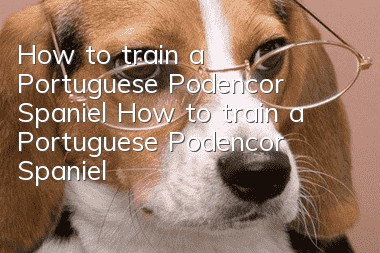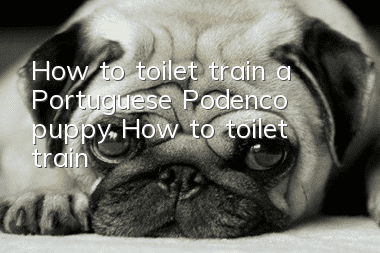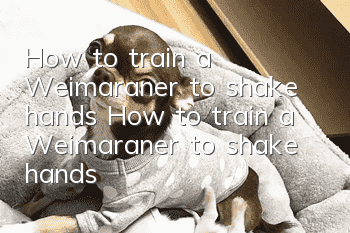How to train a Portuguese Podencor Spaniel How to train a Portuguese Podencor Spaniel

How to train the Portuguese Podenque? The Portuguese Podenque is a very lively hunting dog, so their temperament is relatively wild. If they are not trained to a certain extent, they will be very naughty.
Train early and keep training:
The smarter the dog, the longer it will take to train. For example, Boxers over a year old may be difficult to train, whereas German Shepherds and Poodles have a lifetime of opportunities to correct their behavior. A dumb dog will retain the habits it developed as a child throughout its life (such as the boxer just mentioned), while a smart dog may continue to develop new habits and adjust old habits. This means that if you are lazy, stop training your dog , and no longer insists that it should obey the instructions it has learned, the smart dog will think that the situation has changed and the old habits no longer apply. Therefore, every time you train your dog, be sure to let it practice every command it has learned. If it doesn't respond correctly, you have to correct it and then praise it. Always remember these three steps: "give orders, correct, and praise." The dog will respond appropriately to avoid being corrected, but it must ultimately accept the praise.
While you should get your dog trained as early as possible, don’t rush it. You need to review the commands it has learned frequently to make sure it fully understands what you are teaching it. But after the dog knows all the basic commands, it has learned how to learn, take full advantage of this ability, and start teaching it new commands. You can teach it to beg, roll, play dead, pray, and say yes on command. A smarter dog must understand that there are always new things waiting for it to learn, and it knows that as long as it obeys the instructions, it will be rewarded. This will allow the dog to always pay attention to the owner's actions and keep his mind alert.
You shouldn’t let your dog get rewards for no reason. Even if you just want to pet him, you must command him to come or sit before petting him or feeding him treats. Use this method to continuously deepen the impression on the dog: as long as I obey the instructions, I can get rewards. This is the most effective training method. Your orders and direction must be consistent throughout the entire training period. Smarter dogs will view various commands as problems to be solved and try their best to find the answers in order to win rewards. Don't ruin the fun of the game by changing the rules.
Control your emotions: Smarter dogs are more likely to detect their owner's emotional state than less smart dogs. Therefore, when facing a smart dog, you should always pay attention to and control your emotions. Never confront a dog with too much anger. The dog will detect the anger and is likely to respond with an aggressive and defensive attitude. Even if it does not adopt an offensive and defensive posture, it will still remember that you have shown angry emotions, making it afraid to approach you. Of course, when you correct your dog's behavior, be careful not to injure it.First think about whether the corrective action may hurt the dog and try to avoid it. For example, if you are training a dog with long ears, be careful that the collar presses on the long ears when you correct its behavior.
Never show fear in front of dogs. Dobermans, German Shepherds, Rottweilers, Poodles or other smart dogs can easily detect human anger or fear and may challenge you. authority. Even if you feel nervous about being around a big dog, you must maintain your attitude and emotional stability. Be firm, but not too harsh, and ask the dog to obey every command. Here is a trick: "Teach your dog to obey the "down" and "don't move" commands when he is still young. Let this command become a command that he absolutely obeys, which will be helpful for your training.
Observe your dog’s behavior carefully:
A smarter dog should respond quickly to all commands. The Newfoundland is certainly slower than the Poodle, but once the dog learns the commands, it will respond as quickly as possible. You should encourage your more intelligent dogs to respond quickly whenever possible. If it doesn't respond quickly, you should correct its slow motion. Sometimes, the dog moves slower simply because the smart dog is still waiting to see if there is a chance to escape the torment. Remember to give him praise after correcting his behavior.
A common mistake people make is to expect too much from smart dogs. Before correcting a behavior that it doesn't respond to correctly, make sure it has actually learned the command. Pushing an intelligent dog too hard will put too much pressure on it and it may lose interest in learning.
Don’t overtrain: Dogs can learn many tasks and should be exposed to as many novel things as possible, but you should avoid overtraining them with a single command. Overly repetitive training for a less intelligent dog is likely to lead to boredom for an intelligent dog. You should set aside a few days or weeks without contacting any commands that the dog has already learned. During this time, you can teach it some new commands, but do not repeat the old commands and activities.
Give the dog appropriate stimulation:
Smart working dogs make lovely life companions, but they also need mental stimulation. Although training can provide a dog with some stimulation, it still needs other sources of stimulation. Exercising or walking in strange and new places, meeting new people, or even just following the owner out to run errands or go shopping can keep the dog mentally sharp and happy. If your dog is an intelligent breed but has behavioral issues, ask yourself if the dog is bored. He may dig, chew, jump, or even try to escape because these activities are much more fun than lying around all day waiting for you to come home.
Some lively and intelligent dogs are easily overexcited. They are often too excited to concentrate on learning commands. Training these dogs is best done in a quiet location. When the training time is over, newer and more exciting things are needed to keep these dogs happy!
- How to pluck the ear hair of a short-legged terrier? How to pluck the ear hair of a short-legged terrier?
- How to train a short-legged and long-body terrier How to train a short-legged and long-body terrier
- How to train a short-legged and long-bodied terrier to pounce and bite. How to train a short-legged and long-bodied terrier to pounce and bite?
- How to train a Portuguese Bodenco puppy to come back? How to train a Portuguese Bodenco dog to be obedient?
- How to train a Short-legged and Long-bodied Terrier to eat? How to train a Short-legged and Long-bodied Terrier to eat etiquette
- What can’t Border Terriers eat? Introduction to Border Terrier taboo foods.
- How to train a Weimaraner to sit down Training tips for a Weimaraner to sit down
- What should you pay attention to when raising a Border Terrier? What should you pay attention to when raising a Border Terrier?
- How to feed a short-legged and long-bodied terrier How to feed a short-legged and long-bodied terrier
- How to train a Border Terrier to use the toilet. How to train a Border Terrier to use the toilet.



